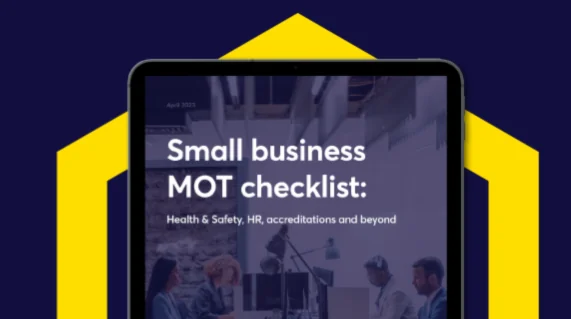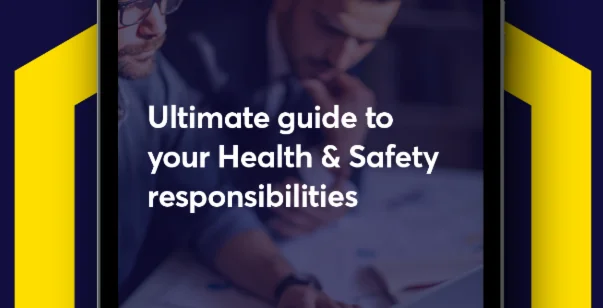In the high-risk construction industry, accident reporting is a vital task that goes beyond just paperwork. For business owners, HR managers, Health & Safety managers and contractors, understanding the role accident reporting has on your site could make a world of difference to the safety at your workplace.
In this article we’ll explore how effective construction accident reporting can significantly reduce workplace incidents, improve site safety, and protect your workforce. We’ll also take a look at the essential steps in incident reporting in construction and how to use the data you collect to build a safer, more compliant work environment.
What is an accident report in construction?
At its core, accident reporting is the process of documenting incidents, including accidents, near misses, and hazardous conditions. It’s a fundamental practice across various industries, designed to capture the details of events, understand their causes, and prevent them from happening again.
This process involves gathering information about what happened, who was involved, and the contributing factors, to create a formal record for analysis and improvement.
Accident reports are a tool for reflection and improvement. By detailing every aspect of an incident from environmental conditions to equipment used, accident reports provide a comprehensive view of incidents that happen onsite.
Analysing these reports means you can identify patterns, pinpoint potential hazards, and put preventative measures in place. These reports are a great way of making sure that lessons are learned from past incidents to prevent future occurrences.
What is the purpose of accident reporting?
Accident reporting serves many purposes within the construction industry. The main purpose of accident reporting on your construction site is to identify root causes of site specific incidents.
Making sure a thorough investigation is carried out, along with completing detailed documentation surrounding the incident means you can pinpoint what might have caused that incident. This investigation and documentation will allow you to put strategies in place to reduce risks.
Beyond safety improvements, incident reporting in construction is essential for legal compliance. Those responsible for Health & Safety on construction sites have a legal obligation to report specific accidents and injuries under the Reporting of Injuries, Diseases and Dangerous Occurrences Regulations (RIDDOR).
However, best practice is that all incidents, even those not legally reportable under RIDDOR, should still be thoroughly logged and documented. This comprehensive approach makes sure you’ve got a complete record of all on-site events.
Want to know more about RIDDOR and which accidents are reportable under the regulations? Check out the full HS Direct guide to RIDDOR!
Importance of accident reporting on construction sites
Accident reporting on your construction site is vital for effective safety management. Carefully documenting incidents gives you insights that drive proactive safety measures and keep you legally compliant.
Let’s explore some of the reasons accident reporting is so important on your site.
Prevents future accidents
One of the main benefits of accident reporting is its preventative potential – by examining the details of a past incident, those responsible for Health & Safety can put changes in place to avoid things happening again.
This could involve switching up work processes to eliminate hazards, improving employee training to address specific risks and teach best practices, or introducing new safety equipment or personal protective equipment (PPE) to provide additional layers of protection.
Accident reports bring vulnerabilities within workplace practices to light, and allow safety managers to create targeted strategies to address specific areas of risk.
Promotes a safe culture
Accident reporting is a vital part of promoting a culture that champions Health & Safety on your construction site. When incidents are reported by employees and addressed quickly, it sends a message to everyone that their safety is a top priority. It also encourages workers to stay vigilant and report hazards that they encounter before they cause accidents.
A strong safety culture is bolstered by open communication and mutual respect, and accident reports provide a structured way for employees to share their concerns and experiences, and for safety managers to take those seriously.
Taking these reports seriously and acting on them shows your commitment to employee wellbeing, further solidifying the message that safety is a shared responsibility. This transparency and responsiveness contribute to a positive safety culture, where everyone feels responsible for creating a safer work environment.
Facilitates investigations and corrective action
Accident reports are also crucial for making investigations easier. They provide a detailed account of incidents and allow safety officers to identify the causes and determine the best course of action.
The insights from these investigations can help when putting together plans to improve safety and address the root cause of the issue. Understanding the root causes of incidents means you can create targeted safety improvement plans, addressing specific hazards and preventing them from happening again.
This data-driven approach ensures that corrective measures are based on factual evidence, leading to more effective and sustainable safety improvements.
Reduce costs
Effective accident reporting can lead to big cost reductions for construction companies. Preventing accidents means companies can avoid expenses that come with downtime, equipment damage and compensation claims. Accident reporting can also help identify inefficiencies within your operations.
Analysing accident reports gives you the ability to identify patterns and trends that highlight areas where processes can be improved. For example, recurring equipment malfunctions may show the need for better maintenance procedures.
Plus, keeping your work environment safe reduces the likelihood of costly legal battles, fines and penalties related to non-compliance.
Legal responsibilities
Accident reporting is a legal requirement in the construction industry, and companies are obligated to report certain incidents to the Health and Safety Executive (HSE).
Failing to comply with these regulations can result in severe penalties, including fines and legal actions. Accident reports can also be used as evidence that a company is meeting its legal obligations and taking proactive steps to improve workplace safety.
How to make an accident report in construction
Creating a comprehensive and effective accident report for a construction site is crucial for ensuring safety, compliance, and continuous improvement. It involves a few key steps, which we have detailed below:
Who should write the accident report?
Typically the person responsible for writing an accident report is the person responsible for Health & Safety – this could be a supervisor, a business owner, contractor or even a dedicated Health & Safety manager.
It’s crucial that the person writing the report stays impartial and objective, making sure all relevant information is properly recorded without bias.
When should an accident report be made?
Accident reports should be made as soon as possible following an incident for accuracy and compliance. Quick reporting ensures all details are fresh in the minds of those involved, and minimises the risk of memory lapses or inaccuracies. It also allows for immediate corrective actions to be put in place.
Reporting it quickly is also important for regulatory compliance. Certain types of accidents, particularly those involving serious injuries or fatalities, must be reported to the Health and Safety Executive (HSE) within specific time frames.
Keeping to these deadlines is essential for avoiding potential penalties and demonstrating a commitment to workplace safety.
What to include in your accident report
To make sure your report is comprehensive, this is the information you should include:
Details of the incident
- Date and time of the incident: Record the exact date and time the incident occurred. This information is vital for establishing a timeline of events and can be crucial for legal and investigative purposes.
- Location of the incident: Specify the exact location where the incident took place. This information helps you find the area of risk and allows you to introduce targeted corrective actions.
- Description of events leading up to an incident: Provide a clear and concise narrative of the events that happened before the incident. Include details such as the tasks being carried out, the order of events, and any unusual circumstances or observations. This helps establish context and identify potential contributing factors.
People involved
- Names and contact information of those involved: Record the names and contact details of all individuals directly involved in the incident, including injured workers, witnesses, and supervisors. This information is crucial for follow-up investigations, communication, and potential legal proceedings.
- Witness statements: Gather detailed statements from witnesses who observed the incident. These statements should include their account of the events, their perspective on potential causes, and any relevant observations.
Equipment and materials
- List of equipment and materials used: Include specific details such as model numbers, serial numbers, and any relevant safety features. This information helps assess the potential role of equipment malfunction or improper usage in the incident.
- Condition of the equipment at the time of the incident: A detailed description of the condition of the equipment involved at the time of the incident.
Environmental conditions
- Weather conditions: If relevant, document the weather conditions at the time of the incident.
- Lighting and visibility: Describe the lighting conditions and visibility at the location of the incident. Poor lighting or obstructed visibility can contribute to accidents, and this information can inform corrective actions to improve site illumination.
Injuries and damages
- Description of any injuries sustained: Provide a detailed description of any injuries sustained by individuals involved in the incident. Include the type of injury, location on the body, and severity.
- Extent of property damage: Document any property damage resulting from the incident. This may include damage to equipment, structures, materials, or the surrounding environment.
Including all these details means the report will provide a full picture of the incident, meaning proper analysis and corrective action can take place.
Types of accident reports in construction
Accident reports might change depending on the incident that’s happened on your construction site. You need to understand the differences between each type of report so you can properly document and address each situation.
Injury reports
Injury reports document any harm sustained by workers on site, such as cuts, lacerations, slips, trips or falls from height. They include details of the injury, medical treatment received and any time off work needed for recovery.
Analysing injury reports means you can identify trends and patterns in workplace injuries, so you can put in place targeted safety measures to prevent similar incidents from occurring in the future.
Property damage reports
Property damage reports focus on incidents that result in damage to equipment, structures or materials. Some examples of property damage that might warrant a damage report could be tool or equipment damage, collapsing of scaffolding or even collisions involving vehicles on site.
These reports can help when looking at the financial impact of an incident and seeing what repairs or replacements need to be made.
Near miss reports
Near miss reports document incidents that could have resulted in injury or damage but didn’t, for example if an employee slips from a scaffolding and catches themselves or if something falls from height and narrowly misses a worker.
These are valuable for identifying potential hazards and putting preventative measures in place before an actual incident occurs.
Ready to implement accident reporting on your site?
For more resources on accident reporting and Health & Safety management, take a look around our website. Download our free guide on Health & Safety responsibilities to understand more about your legal obligations around accident reporting, or check out our accident reporting poster designed to drive awareness of Health & Safety best practices across your business and premises.
Or, for a more all-in-one solution check out our Safety First Package, which comes complete with accident reporting capabilities to streamline your processes and make sure you’re staying on top.
Want to chat with a member of the team about your Health & Safety needs? Just call 0161 826 8967 or contact us to request a callback.





